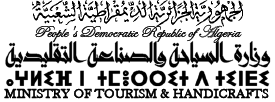This work is carried out by women and is growing in: Ahaggar, Tidikelt, Ablessa, Silete and Adles. Esslala matches plant fibers (Alfa and palm trees) with the multicolored woolen threads. The most important productions: Folding screens (Isber), carpets, food protection panniers, fans, baskets and serving trays (Tadara and Tasskate).Palm tree fiber made Tidikelt famous. Craftsmen transform palm tree fibers into finished products (bags and beds) thanks to an ancient skill.


These local adornments differ in theirforms and in their decorative parts.This activity is performed by mastercraftsmen and Goldsmiths, practicingin workshops and craftwork centers,in the municipalities of Tamanrasset.Jewels that enjoy attention: earrings,anklets (khelkhal), large threewayothers: Telkhocam, tiroute, adlel,assrou, timidiouan in tiskouar..
T h e d e c o r a t i o n s o f T i d i k e l t
stand out thanks to their fashion shaping, their forms, their volumes, andtheir manufacturing standards. Berber decoration represents their dominantstyle. They are patterned silver wires which are sealed on the ornamentsThe granular decoration gives them a style of roughness.
The granular decoration gives them a style of roughness.the last ones for feet.


In order to cope with the requirement of daily life, women work in leather business.This work is achieved in the area of Ahaggar. Its two main characteristics; richnessand diversity: tents, leather bags, food protective bags, shoe soles and belts.In the region of Tidikelt this activity is important. Its craftspeople produce shoesoles, bedding products, bags and shoes


The Kheïma is made from leather. Itstanning is primarily borne by womenusing plant products. Working has tobe smooth, feels good to the touch andred in color. The processed materialis cut into suitable pieces which aresewn with a leather thread. The pitchingof the tent begins at first withthe attachment of the principal partsand the columns. Then, it is decoratedwith geometric patterns. The tent isfirmly clamped to the ground at itsedges. Inside, it’s surrounded by along rectangular carpet and furnishedwith various carpets.ss


From wood, craftsmen make products intended for their daily needs: woodenspoons, tent columns, tindi, wooden dishes, stylus or pencil of Khôl and jewelryboxes.


Pottery has always addressed the requirementsof daily life. Therefore, it is regardedas one of the oldest industries thatsought to promote economic and culturaldevelopment. The quality and the diversityof the clay product made Tidikelt (area ofInguer) well-known. The site also provides:tableware, kitchen utensils, beveragecontainers, aesthetic tools and percussioninstruments (Guellal, drums…). Targuibwomen are very good at the manufacture ofproducts having different volumes and decoratedwith simple designs or through Berbersymbols: kettles, storage containers formilk and water, vessels and others…lented fingers of skilled craftsmen.


Traditional clothing is distinguished byone and only style. Targui women wearDraa with outer clothing called Nilacapped with “Tarf” similar to Haïk (Garbouz),black in color and relatively short.
They put on leather shoes. They dresscloth called Bazan (Tisseghness). In theTidikelt city area, it is the female clothingel jawali that prevails; it is also the favoriteclothes of married women. Somewomen get dressed of Taoub. The dressof the Targui man consists of three mainparts: the pants (Akerby), Gandoura(arassoui) and TagamissetAnkoura that looks like arassoui. He covers his face(forehead, bottom of the eyes and nose)with a scarf called Litham. He carries silver
rings and he puts on an elbow a polishedring made of stone. Around the neckhe raises proudly, in the form of bracelets,a decorated leather girdle, talismansand small leather bags. The Man of Tidikeltwears a Gandoura, Arabic trousersand slippers.




